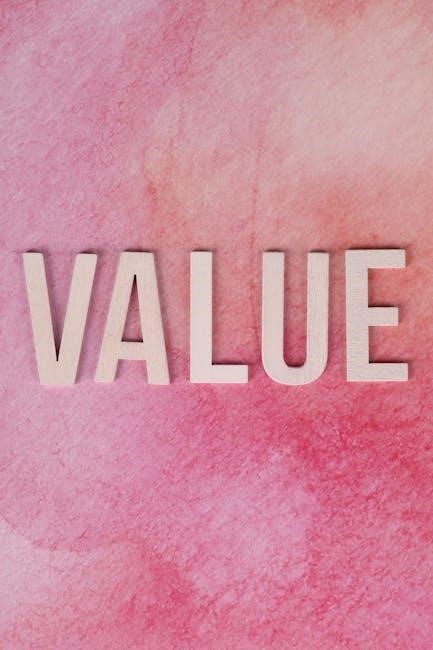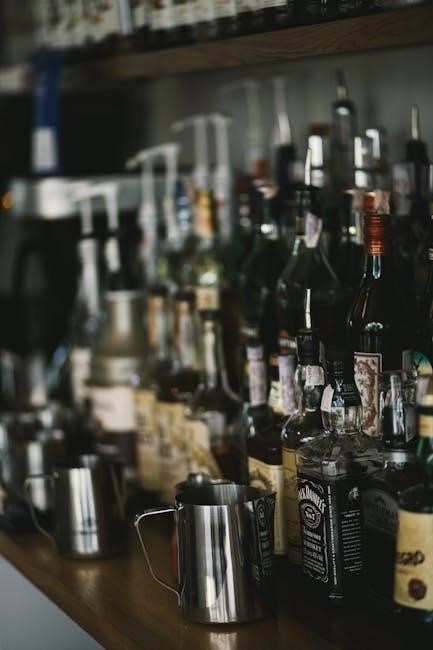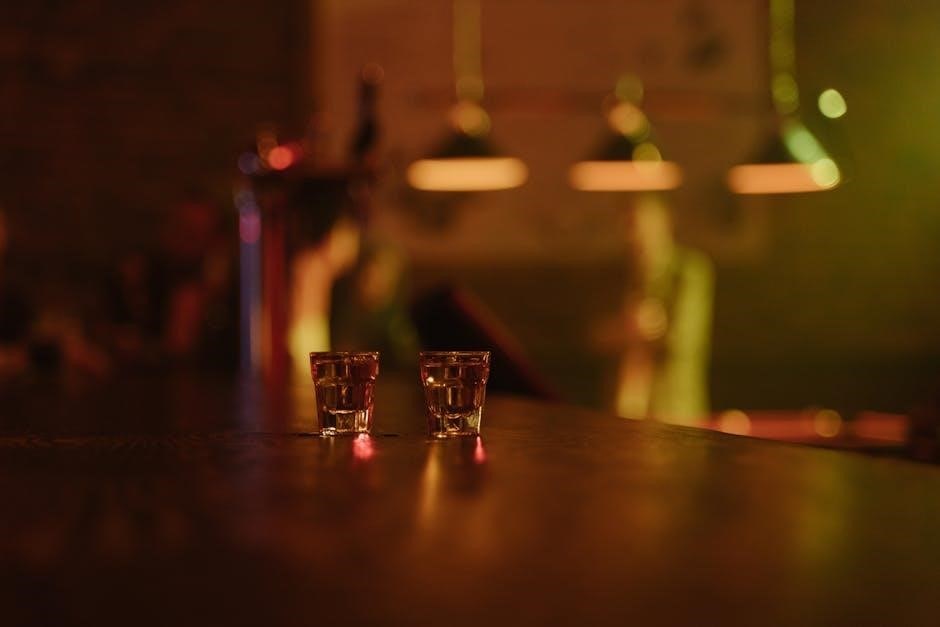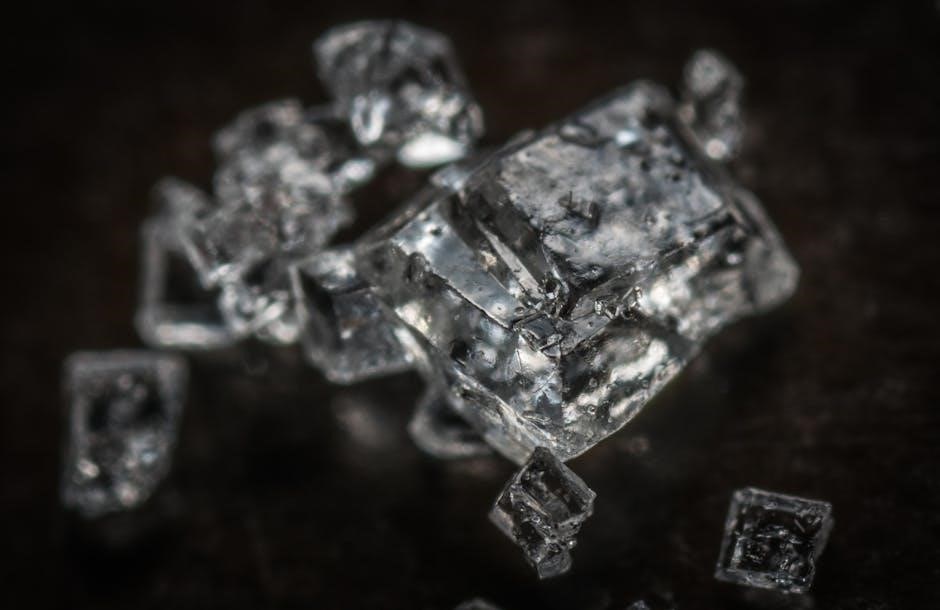Bourbon is a quintessential American whiskey, rich in history and craftsmanship. This guide explores its value, from production rules to tasting tips, helping enthusiasts appreciate its complexity and worth.
Definition and Origin of Bourbon
Bourbon is a type of American whiskey that originated in Bourbon County, Kentucky, in the 18th century. To qualify as bourbon, whiskey must meet strict criteria: it must be made in the U.S., contain at least 51% corn in its mash bill, aged in new, charred oak barrels, and distilled to no more than 160 proof. Bourbon is known for its rich, full-bodied flavor profile, often featuring notes of vanilla, caramel, and oak. The name “bourbon” is tied to its historical roots, and its production methods have been refined over centuries, making it a cornerstone of American spirits.
Historical Background of Bourbon Production
Bourbon production has deep roots in American history, tracing back to the 18th century. Early settlers in Kentucky, including Scottish, Irish, and English immigrants, brought their whiskey-making traditions to the region. The fertile land and access to pure limestone water made Kentucky an ideal place for bourbon production. The name “bourbon” is linked to Bourbon County, where it was first produced. Over time, bourbon evolved through innovations like the use of charred oak barrels, which impart distinctive flavors. Prohibition in the early 20th century nearly halted production, but bourbon rebounded post-repeal, becoming a symbol of American craftsmanship and heritage. Today, it remains a cornerstone of the spirits industry.
Bourbon vs. Other Types of Whiskey
Bourbon stands distinct among whiskeys due to its strict production standards. Unlike Scotch or Irish whiskey, bourbon must be made in the U.S., primarily from corn, and aged in new, charred oak barrels. Its flavor profile, rich in vanilla and caramel notes, differs from rye whiskey, which is spicier due to higher rye content. Tennessee whiskey, another American variety, undergoes an extra filtering step called the Lincoln County Process, setting it apart from bourbon. These differences in ingredients, aging, and production methods contribute to bourbon’s unique character and value in the world of whiskey.

Understanding Bourbon Value
Bourbon’s value is shaped by age, mash bill, proof, and rarity. These factors influence flavor complexity, scarcity, and demand, making some bottles highly sought after and valuable.
Factors Influencing Bourbon Value
Several factors influence the value of bourbon, including age, mash bill, proof, and rarity. Age impacts complexity, with older bourbons often commanding higher prices due to prolonged aging. The mash bill, or grain recipe, affects flavor profiles, making certain bourbons more desirable. Higher proof bourbons, especially cask-strength, are prized for their potency and flavor intensity. Rarity, such as limited editions or single-barrel releases, drives up demand and value. Secondary market tools like the Bourbon Blue Book help determine fair market prices, while provenance and storage conditions also play roles. These elements combine to make bourbon both a sippable luxury and a valuable commodity, appealing to both enthusiasts and investors.

Age and Its Impact on Bourbon Value
Age significantly influences bourbon’s value by enhancing complexity and smoothness. Older bourbons, aged for 8–20+ years, develop deeper flavors of oak, vanilla, and caramel, increasing their appeal. Extended aging can elevate a bourbon’s status, with rare, decades-old bottles commanding high prices. However, over-aging risks over-oaking, which may detract from value. Age statements on labels guide consumers, with older bourbons often priced higher. Market demand for aged bourbons drives their premium pricing, making them desirable for collectors and connoisseurs. Thus, age remains a critical factor in determining bourbon’s value and allure in the market.
The Role of Mash Bill in Determining Value
The mash bill, a recipe of grains like corn, rye, barley, and wheat, is central to bourbon’s flavor and value. High-rye bourbons, offering spicy notes, often fetch premium prices due to their bold profile. Wheated bourbons, using wheat for a smoother taste, also gain value for their unique character. The proportion of each grain affects complexity and desirability, with certain mash bills becoming sought after by enthusiasts. Limited editions with unique grain recipes can elevate value, while traditional recipes remain timeless. The mash bill’s impact on flavor and uniqueness makes it a key factor in determining bourbon’s value and appeal in the market.
Proof and Its Effect on Bourbon Pricing
Proof, or alcohol by volume (ABV), significantly influences bourbon pricing. Higher-proof bourbons are often perceived as more premium, commanding higher prices due to their intensity and complexity. Cask-strength bourbons, typically bottled at 120 proof or higher, are particularly sought after by enthusiasts, driving up their value. Lower-proof bourbons, while still high quality, may be more accessible and affordable. The relationship between proof and price also reflects consumer preferences, as some drinkers prefer the boldness of higher-proof spirits, while others opt for a smoother, lower-proof experience. Ultimately, proof is one of several factors, alongside age and mash bill, that collectively determine a bourbon’s value and appeal.
Rarity and Limited Edition Bourbons
Rarity and limited editions play a significant role in determining bourbon value. Limited-production runs create exclusivity, driving demand and prices. Bourbons like Michter’s Sour Mash Celebration, aged 20-30 years, fetch thousands due to scarcity. Special releases often feature unique mash bills or aging techniques, enhancing their appeal. Collectors and enthusiasts seek these bourbons, pushing their value higher. The perception of exclusivity and craftsmanship elevates their status in the market. As such, rarity is a key factor in bourbon’s premium pricing and desirability. Limited editions also foster a sense of urgency among buyers, further inflating their value. This dynamic makes rare bourbons highly sought after and valuable additions to collections.

Popular Bourbon Styles and Their Value
Bourbon styles vary, each offering unique flavor profiles and value. Straight, cask-strength, and single-barrel bourbons are prized for their complexity, while wheated and high-rye bourbons offer distinctive tastes, impacting pricing.

Straight Bourbon: Characteristics and Value
Straight bourbon is aged for at least two years, with no added flavorings or colorings. Its value lies in its authenticity and depth, offering rich vanilla, oak, and caramel notes. Bottled at 80 proof or higher, it’s sought after for its classic profile. The aging process enhances complexity, making older straight bourbons highly prized. These bourbons are ideal for purists, providing a true representation of traditional craftsmanship. Their value increases with age, making them a solid choice for both enthusiasts and collectors. Straight bourbons are a cornerstone of any bourbon collection, embodying the spirit of American whiskey’s heritage.
Cask-Strength Bourbon: Pricing and Popularity
Cask-strength bourbon is bottled straight from the barrel, typically between 120-140 proof. Its unfiltered, full-bodied flavor has surged in popularity among enthusiasts, commanding premium pricing due to its potency and authenticity. The absence of dilution preserves the whiskey’s natural characteristics, appealing to connoisseurs seeking a robust experience. Prices often exceed $100, reflecting its exclusivity and quality. Limited editions further drive demand, making cask-strength bourbons highly sought after. Their popularity stems from the ability to customize the drinking experience by adding water, enhancing complexity. This segment attracts serious collectors and aficionados, solidifying its place in the premium bourbon market.
Single-Barrel Bourbon: What Makes It Valuable
Single-barrel bourbon is highly prized for its uniqueness and craftsmanship; Unlike blended bourbons, it is bottled from a single oak barrel, ensuring distinct flavor profiles. Each barrel ages differently, creating a one-of-a-kind taste experience. This exclusivity drives its value, often ranging from $50 to over $200. The absence of blending allows drinkers to appreciate the barrel’s individual character, making it a favorite among connoisseurs. Limited availability and the allure of personal selection further enhance its appeal. Single-barrel bourbons are sought after for their complexity and rarity, making them a standout in any collection.
Small-Batch Bourbon: Quality and Cost
Small-batch bourbon is celebrated for its quality and craftsmanship, offering a balanced blend of flavors. Produced in limited quantities, these bourbons are carefully selected from a few barrels, ensuring consistency and character. The smaller production scale allows distillers to maintain precision, resulting in a premium product. Prices typically range from $40 to $100, reflecting the attention to detail and higher-quality ingredients. Small-batch bourbons are popular among enthusiasts for their approachable yet complex profiles, making them a great middle ground between everyday sippers and rare collectibles. Their moderate pricing and refined taste make them an excellent choice for those seeking value without compromising on quality.

Wheated Bourbon: Unique Profile and Value
Wheated bourbon stands out for its smooth, mellow profile, achieved by substituting rye with wheat in the mash bill. This creates a lighter, sweeter flavor with notes of vanilla, caramel, and oak. Brands like Maker’s Mark and W.L. Weller are renowned for their wheated expressions. Generally priced between $30 and $80, these bourbons offer excellent value for their approachable taste. Their lower proof and absence of spicy rye notes make them ideal for newcomers and those preferring a softer whiskey. Wheated bourbons are versatile, suitable for sipping or mixing, offering a unique experience that combines quality with affordability, appealing to a wide range of palates and preferences.
High-Rye Bourbon: Distinctive Flavor and Pricing
High-rye bourbon is celebrated for its bold, spicy flavor profile, with rye content often exceeding 15%. This higher rye proportion enhances the whiskey’s complexity, offering notes of pepper, mint, and dried fruit; Brands like Bulleit and Woodford Reserve exemplify this style, balancing spice with sweetness. Priced between $40 and $100, high-rye bourbons are sought after for their robust character and versatility in cocktails. Their distinctiveness makes them a favorite among enthusiasts, providing excellent value for those who appreciate a strong, spicy backbone in their bourbon. This style is particularly popular for its ability to stand out in mixed drinks while remaining enjoyable neat or on the rocks.

Tennessee Bourbon: Production Methods and Value
Tennessee bourbon is distinguished by its unique filtration through sugar maple charcoal, known as the Lincoln County Process, imparting a smoother, mellow flavor. Brands like Jack Daniel’s and George Dickel employ this method, resulting in a lighter, sweeter profile with hints of caramel and vanilla. Priced moderately, Tennessee bourbons range from $30 to $80, offering excellent value for their quality and distinct character. Their approachable taste makes them accessible to both newcomers and connoisseurs, providing a versatile option for sipping or mixing. The combination of traditional techniques and regional ingredients sets Tennessee bourbon apart, making it a valuable addition to any collection or bar.

Bourbon Buying Guide
Discover the best bourbons tailored to your taste and budget with expert tips on selecting, storing, and sipping. Explore styles, read reviews, and shop smart.
How to Determine Your Budget for Bourbon
Setting a budget for bourbon involves balancing quality, availability, and personal preference. Entry-level bourbons often range between $30–$50, offering excellent value for everyday enjoyment. Mid-range options, typically priced from $50–$100, provide greater complexity and are ideal for special occasions. For premium and rare bourbons, expect to spend $100–$500 or more, as these often come from limited editions or high-end distilleries. Consider your objectives—whether for sipping, collecting, or gifting—to guide your spending. Additionally, factor in storage costs if you plan to age bottles, as proper care can preserve value. Researching reviews and market trends helps ensure you invest wisely within your means.
Researching Bourbon Before Purchase
Researching bourbon before purchase is crucial to making informed decisions. Start by understanding your preferences and budget. Read reviews from trusted sources like whiskey blogs, forums, and expert ratings. Tools such as the Bourbon Blue Book and Bourboneur provide detailed valuations and market insights. Explore distillery websites to learn about production methods and age statements. Additionally, compare prices across retailers and online platforms to ensure fair pricing. Consider the reputation of the distillery and the transparency of labeling. For rare or limited editions, verify authenticity and provenance to avoid counterfeits. Consulting with experts or joining bourbon communities can also offer valuable recommendations. This due diligence ensures you find a bourbon that aligns with your tastes and investment goals.
Understanding Bourbon Labels and Terminology
Understanding bourbon labels is essential for making informed purchases. Terms like “straight bourbon” indicate no added flavorings or coloring, while “small-batch” suggests a limited production run. “Age statements” reflect the youngest whiskey in the bottle, impacting value and complexity. “Proof” refers to alcohol content, with higher proofs often commanding premium prices. Labels may also mention the “mash bill” (grain recipe) or whether the bourbon is “cask-strength” (undiluted). Terms like “wheated” or “high-rye” describe the grain composition. Additionally, phrases like “Produced by” vs. “Distilled by” clarify the origin. Familiarizing yourself with these terms helps you navigate the market and select bourbons that align with your preferences and budget.
Consulting Experts and Reviews for Bourbon Selection
Consulting experts and reviews is a valuable step in selecting bourbon, especially for those new to the spirit. Bourbon enthusiasts often rely on trusted sources like bourbon blogs, forums, and expert reviews to discover hidden gems and avoid overpriced bottles. Tools like the Bourbon Blue Book and Bourboneur provide detailed valuations and insights, helping buyers make informed decisions. Additionally, whiskey experts and distillery ambassador recommendations offer firsthand knowledge of production methods and flavor profiles. Reading reviews from multiple sources ensures a balanced perspective, while joining bourbon communities can connect you with fellow enthusiasts who share tips and experiences. Leveraging these resources enhances your bourbon journey and helps you find bottles that align with your palate and budget.
Where to Buy Bourbon: Retailers, Online Platforms, and Auctions
When seeking to purchase bourbon, enthusiasts have various options to explore. Local retailers offer personalized recommendations and the convenience of tasting before buying, though their selections may be limited. Online platforms provide a broader range of bourbons, but caution is necessary to ensure authenticity and reliability. Auctions are ideal for rare and limited-edition bottles, catering to serious collectors willing to invest. Utilizing secondary market tools for valuation can aid in making informed decisions, helping buyers and sellers determine fair prices; Balancing convenience, selection, and authenticity is key to a satisfying bourbon purchase, whether through local shops, trusted online sellers, or exclusive auctions.
Avoiding Counterfeit Bourbon: Tips and Tricks
Avoiding Counterfeit Bourbon: Tips and Tricks
Counterfeit bourbon is a growing concern, especially for rare and high-value bottles. To avoid falling victim, always purchase from reputable retailers or trusted online platforms. Verify the seller’s authenticity and check for certifications. Inspect the bottle for any inconsistencies in labeling, spelling, or packaging. Use tools like the Bourbon Blue Book to research and validate the bottle’s legitimacy. Be cautious of overly discounted prices, as they may indicate a fake. Additionally, consider using UV light tests to detect counterfeit seals or labels. When buying online, ensure secure payment methods and track shipments. Remember, counterfeit bourbon not only wastes money but also poses legal risks. Diligence is key to ensuring your purchase is genuine and worth its value.

Bourbon Investment and Collecting
Bourbon investment offers a unique opportunity to combine passion with profit. Rare bottles can appreciate significantly, blending history, craftsmanship, and market demand. A trusted valuation guide ensures informed decisions, making bourbon a coveted asset for collectors and enthusiasts alike.
How to Start a Bourbon Collection
Starting a bourbon collection begins with defining your goals and budget. Determine if you aim to collect rare bottles, explore diverse styles, or focus on specific distilleries. Research key factors like age, mash bill, and proof to guide your selections. Begin with accessible, highly-regarded bourbons to build a foundation. Consider purchasing from reputable retailers or secondary markets for rare finds. Store bottles in a cool, dark place to preserve quality. Document your collection to track value and provenance. Gradually expand by exploring different styles and regions. Join bourbon communities for insights and advice. Remember, building a meaningful collection is a journey of discovery and appreciation.
Investing in Bourbon: Risks and Rewards
Investing in bourbon can offer significant rewards, with rare bottles appreciating substantially over time. However, it comes with risks, such as market fluctuations and the potential for counterfeit bottles. To mitigate these risks, focus on purchasing from reputable sources and verifying authenticity through provenance. Secondary market tools like the Bourbon Blue Book can help assess value and track trends. High-demand bourbons, such as limited editions or aged expressions, often see the greatest returns. Diversifying your portfolio across different brands and styles can reduce risk. Like any investment, patience is key, as value growth may take years. Always research thoroughly and consult experts to make informed decisions.
Using Secondary Market Tools for Bourbon Valuation
Secondary market tools are essential for accurately valuing bourbon collections. Platforms like the Bourbon Blue Book provide comprehensive pricing data, helping collectors and investors determine fair market values. These tools analyze historical sales, current trends, and rarity to offer precise valuations. Additionally, apps and websites track bottle popularity and auction results, ensuring up-to-date information. For rare or limited-edition bourbons, these resources are invaluable in assessing worth. By leveraging these tools, enthusiasts can make informed purchasing or selling decisions, ensuring they get the best value. Regularly updating your knowledge with these tools is crucial in the dynamic bourbon market.
The Role of Provenance in Bourbon Collecting
Provenance plays a significant role in the value and appeal of bourbon. It refers to the history and origin of a bottle, including its distillery, production date, and ownership lineage. Bottles with well-documented provenance often command higher prices due to their authenticity and rarity. Collectors and investors prize bourbons with verified histories, as they ensure legitimacy and enhance the bottle’s story. Provenance can also include unique identifiers like signatures, labels, or special editions, adding to the bourbon’s exclusivity. A clear and verified provenance not only boosts value but also builds trust in the market, making it a crucial factor in bourbon collecting and trading.
Storage and Maintenance of Bourbon Collections
Proper storage is essential for preserving the quality and value of bourbon collections. Bottles should be kept in a cool, dark place, away from direct sunlight, to prevent degradation. Maintaining a consistent humidity level is crucial, as dry conditions can cause corks to shrink, leading to oxidation. Bourbon should always be stored upright to prevent the cork from rotting or the liquid from coming into contact with the cork excessively. Temperature fluctuations should be avoided, with ideal storage between 50-65°F (10-18°C). Regularly inspecting bottles for signs of damage or spoilage is also important. Additionally, using acid-free tissue or cloth to handle bottles can prevent oils from damaging the labels. Proper maintenance ensures the bourbon remains pristine, retaining its flavor and value over time.

Bourbon Tasting and Appreciation
Bourbon tasting is an art combining technique and sensory exploration. Savoring its rich flavors, from vanilla to oak, requires patience and a refined palate to truly appreciate its complexity.
Basic Bourbon Tasting Techniques
Mastering bourbon tasting involves a structured approach to fully appreciate its complexity. Start by pouring a small amount into a Glencairn glass, allowing the bourbon to breathe. Observe the color and viscosity, which hint at age and proof. Swirl gently to release aromas, then nose the bourbon to detect notes of vanilla, oak, or caramel. Take a small sip, letting it coat your palate to experience the flavor profile. Note the finish, whether smooth or spicy. Repeat to refine your impressions. Consider the proof, as higher proofs may require water to open up flavors. Practice these steps to enhance your appreciation and identify your preferences.
How to Pair Bourbon with Food
Bourbon’s rich, complex flavors make it an excellent companion for various dishes. When pairing, consider the bourbon’s profile—high-rye bourbons pair well with spicy or bold flavors, while wheated bourbons complement sweeter dishes. Classic combinations include pairing bourbon with grilled meats, where its smoky notes enhance charred flavors. For desserts, bourbon’s vanilla and caramel notes align beautifully with chocolate or pecan pie. Cheese boards, especially with rich cheeses like cheddar or blue, also benefit from bourbon’s warmth. Experiment by balancing flavors—sweet with savory, spicy with smooth. Adding a splash of water can open up the bourbon’s nuances, enhancing the pairing experience. This versatility allows bourbon to elevate meals and desserts alike, making it a versatile choice for culinary exploration.
Hosting Bourbon Tasting Events
Hosting a bourbon tasting event is a great way to share your passion and educate others about this iconic spirit. Start by selecting a variety of bourbons that showcase different styles, ages, and proofs. Use Glencairn glasses for optimal aroma and flavor appreciation. Provide water and neutral snacks like crackers or bread to cleanse palates between tastings. Create a guided tasting format, offering notes on nose, palate, and finish. Encourage guests to record their impressions. Set a relaxed atmosphere with dim lighting and comfortable seating. Consider adding food pairings or live music to enhance the experience. Keep the group size manageable to foster meaningful discussion. Lastly, emphasize responsible drinking and provide options for designated drivers. This approach ensures an engaging and memorable event for all attendees.
Bourbon is a timeless spirit, blending craftsmanship and history. This guide has explored its value, from basics to investment. Cheers to your bourbon journey and appreciation!
Final Thoughts on Bourbon Value and Appreciation
Bourbon value extends beyond its price tag, encompassing history, craftsmanship, and personal enjoyment. Whether sipping, collecting, or investing, bourbon offers a rich experience. Understanding its nuances enhances appreciation, making every pour meaningful. From rare bottles to everyday drams, bourbon’s diversity caters to all enthusiasts. Remember, value is subjective—what matters most is the joy it brings. Explore, learn, and savor the spirit that defines American whiskey culture. Cheers to your bourbon journey, wherever it may lead!
Resources for Further Bourbon Exploration
For deeper bourbon knowledge, explore resources like The Bourbon Blue Book and Bourbon: The Rise, Fall, and Rebirth of an American Whiskey by Michael R. Veach. Websites such as BourbonOfTheDay and Great Jones offer detailed guides and tasting notes. Join online communities like Reddit’s r/bourbon for enthusiast discussions. Tools like the Bourbon Blue Book and secondary market platforms help track bottle values. Attend bourbon festivals and tastings to connect with distillers and experts. Authors like Fred Minnick provide insights into bourbon history and trends. Whether you’re a novice or collector, these resources enrich your bourbon journey and keep you informed about the evolving world of American whiskey.
